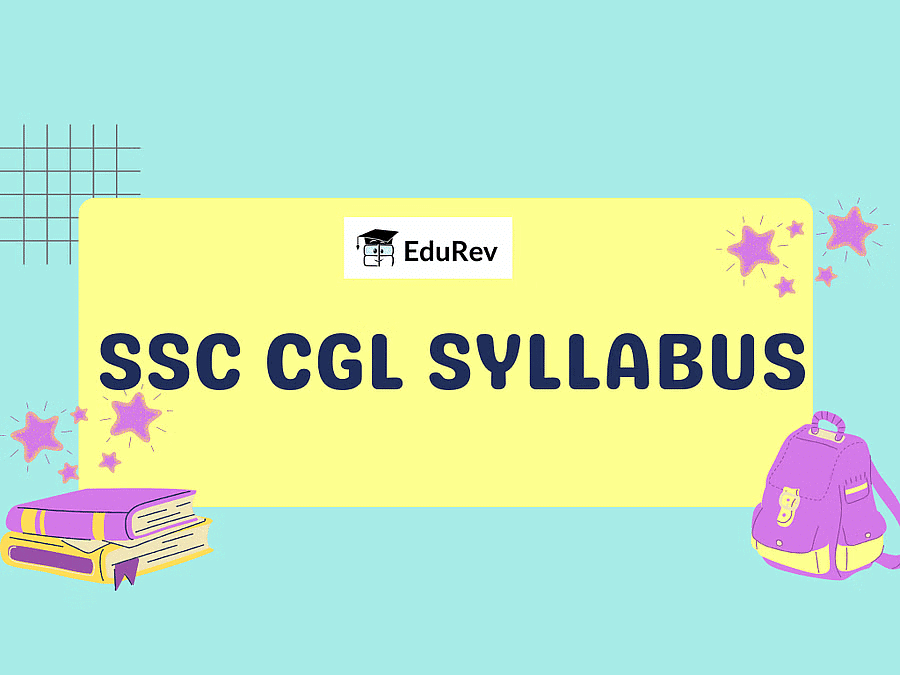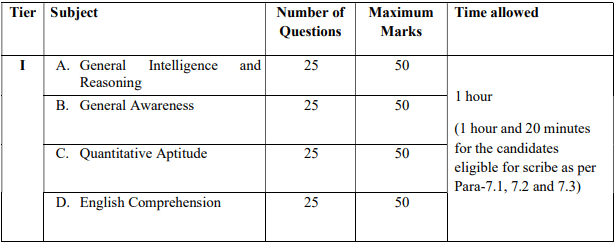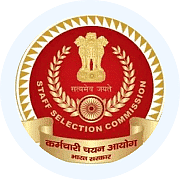Syllabus for SSC CGL 2025 | SSC CGL Tier 1 and Tier 2 Mock Test Series 2025 (New Pattern) PDF Download
The Staff Selection Commission (SSC) has introduced the syllabus for the SSC Combined Graduate Level (CGL) Exam 2025 which accompanies the official notification set to be released in June 2025 for both Tier 1 and Tier 2 examinations. This extensive syllabus plays a crucial role in assisting candidates in their preparation for the upcoming SSC CGL Exam. Understanding the importance of a thorough grasp of the SSC CGL Syllabus 2025 as a crucial foundation for success in the CGL exam.
For your better understanding, EduRev has compiled this guide where the syllabus of all the Tier 1 and Tier 2 exam subjects is given in easy language.

SSC CGL Syllabus 2025
The syllabus for the SSC CGL exam is divided into two distinct phases known as Tier I and Tier II. Both Tier 1 and Tier 2 exams for SSC CGL 2025 are conducted online. Importantly, the Tier 1 exam in SSC CGL is considered qualifying, and the final selection depends on the results of the SSC CGL Tier 2 Exam. To assist candidates, the SSC CGL Syllabus 2025 PDF is available in English in the provided article. Additionally, the SSC CGL Exam Pattern 2025 is explained in the following table for a comprehensive breakdown of information.
| SSC CGL Syllabus 2025 | |
| Exam Name | SSC CGL 2025 |
| SSC CGL Full Form | Staff Selection Commission Combined Graduate Level |
| Conducting Body | Staff Selection Commission |
| Exam Type | National Level |
| Mode of Application | Online |
| Application Dates | June 9th 2025 - 4th July 2025 |
| Exam Dates | 1st Week of September |
| Mode of Exam | Online |
| Basic Eligibility | Indian citizenship & Graduate (bachelor’s degree in relevant discipline) |
| Selection Process | Tier 1 (Qualifying) & Tier 2 |
| Official Website | https://ssc.nic.in/Portal/Syllabus |
Scheme of the Examination
The Computer Based Examination will be conducted in two tiers as indicated below Tier-I & Tier-II
Marks scored by candidates in Computer Based Examinations, if conducted in multiple shifts, will be normalized by using the formula published by the Commission vide Notice No: 1-1/2018-P&P-I and such normalized scores will be used to determine final merit and cut-off marks.
Scheme of Tier-I Examination:
- Tier-I will consist of Objective Type, Multiple choice questions. The questions will be set both in English & Hindi except for English Comprehension.
- There will be negative marking of 0.50 for each wrong answer.
 Scheme of Tier-I Examination
Scheme of Tier-I Examination
Scheme of Tier-II Examination:
- Tier-II will include conducting of Paper-I, Paper-II and Paper-III in separate shift(s)/ day(s).
- Paper-I is compulsory for all the posts.
- Paper-II will be for only those candidates who apply for the posts of Junior Statistical Officer (JSO) in the Ministry of Statistics and Programme Implementation and Statistical Investigator Grade-II in the office of Registrar General of India (M/o Home Affairs) and who are shortlisted in Tier-I for these Posts.
- Paper-III will be for only those candidates who are shortlisted in Tier-I for Paper-III i.e. for the posts of Assistant Audit Officer/ Assistant Accounts Officer.
 Scheme of Tier-II Examination
Scheme of Tier-II Examination
SSC CGL Tier I Syllabus 2025
The SSC CGL Tier 1 examination consists of a total of 100 questions, with a maximum achievable score of 200. The allotted time for the SSC CGL Tier 1 exam is 60 minutes. This Tier I exam is structured into four sections, each containing 25 questions, and has a maximum score potential of 50 marks.
| SSC CGL Tier I Syllabus 2025 | |
| Subjects | Topics |
| General Intelligence and Reasoning |
|
| General Awareness |
|
| Quantitative Aptitude |
|
| English Language |
|
SSC CGL Tier II Syllabus 2025 for Paper I
The online SSC CGL Tier 2 examination will consist of three papers:
| SSC CGL Syllabus 2025 for Tier II | ||
| Section-I of Paper-I (Mathematical Abilities) | ||
| Module | Subject | Topics |
Module I | Number Systems |
|
| Fundamental arithmetical operations |
| |
| Algebra |
| |
| Geometry |
| |
| Mensuration |
| |
| Trigonometry |
| |
| Statistics and probability |
| |
| Module II | Reasoning and General Intelligence | Semantic Analogy Symbolic operations, Symbolic/ Number Analogy, Trends Figural Analogy Space Orientation Semantic Classification Venn Diagrams Symbolic/ Number Classification Drawing inferences Figural Classification Punched hole/ pattern-folding & unfolding Semantic Series Figural Pattern Folding and completion Number Series Embedded figures Figural Series Critical Thinking Problem-Solving Emotional Intelligence Word Building Social Intelligence Coding and decoding Numerical operations Other subtopics, if any. |
| Section-II of Paper-I | ||
| Module I | English Language And Comprehension | Vocabulary One word substitution Sentence structure Shuffling of Sentences in a passage, Fill in the Blanks, Synonyms/Homonyms Shuffling of Sentence parts Spellings/ Detecting misspelt words Idioms & Phrases Improvement of Sentences, Antonyms Active/ Passive Voice of Verbs Conversion into Direct/ Indirect narration Spot the Error English Grammar Cloze Passage |
| Module II | General Awareness |
|
| Section-III of Paper-I (Computer Proficiency) | ||
| Module | Subject | Topics |
| Module I | Computer Basics |
|
| Software | Windows Operating system including basics of Microsoft Office like MS word, MS Excel and Power Point etc | |
| Working with the Internet and e-mails | Web Browsing & Searching, Downloading & Uploading, Managing an E-mail Account, e-Banking | |
| Basics of networking and cyber security | Networking devices and protocols, Network and information security threats (like hacking, virus, worms, Trojan etc.) and preventive measures | |
SSC CGL Tier II Syllabus 2025 for Paper II
Candidates are advised to go through the detailed syllabus of SSC CGL 2025 Tier II Syllabus for Paper II from the below table:-
| SSC CGL Tier 2 Syllabus- Statistics (Paper II) | |
| Subjects | Topics |
| Collection, Classification and Presentation of Statistical Data | Primary and Secondary data, Tabulation of data; Frequency distributions; Graphs and charts; Methods of data collection; Diagrammatic presentation of frequency distributions. |
| Measures of Central Tendency | Common measures of central tendency – mean median and mode; Partition values- quartiles, deciles, percentiles. |
| Measures of Dispersion- Common measures of Dispersion | range, quartile deviations, mean deviation and standard deviation; Measures of relative dispersion. |
| Moments, Skewness and Kurtosis | Different types of moments and their relationship; the meaning of skewness and kurtosis; different measures of skewness and kurtosis. |
| Correlation and Regression | Scatter diagram; simple correlation coefficient; simple regression lines; Spearman‟s rank correlation; Measures of association of attributes; Multiple regression; Multiple and partial correlation (For three variables only). |
| Probability Theory | Meaning of probability; Different definitions of probability; Conditional probability; Compound probability; Independent events; Bayes‟ theorem. |
| Random Variable and Probability Distributions | Random variable; Probability functions; Expectation and Variance of a random variable; Higher moments of a random variable; Binomial, Poisson, Normal and Exponential distributions; Joint distribution of two random variable (discrete). |
| Sampling Theory | Concept of population and sample; Parameter and statistic, Sampling and non-sampling errors; Probability and nonprobability sampling techniques (simple random sampling, stratified sampling, multistage sampling, multiphase sampling, cluster sampling, systematic sampling, purposive sampling, convenience sampling and quota sampling); Sampling distribution (statement only); Sample size decisions. |
| Statistical Inference | Point estimation and interval estimation, Properties of a good estimator, Methods of estimation (Moments method, Maximum likelihood method, Least squares method), Testing of hypothesis, Basic concept of testing, Small sample and large sample tests, Tests based on Z, t, Chi-square and F statistic, Confidence intervals. |
| Analysis of Variance | Analysis of one-way classified data and two-way classified data. |
| Time Series Analysis | Components of time series, Determination of trend components by different methods, Measurement of seasonal variation by different methods. |
| Index Numbers | Meaning of Index Numbers, Problems in the construction of index numbers, Types of index number, Different formulae, Base shifting and splicing of index numbers, Cost of living Index Numbers, Uses of Index Numbers. |
SSC CGL Tier II Syllabus 2025 for Paper III
Candidates are advised to go through the detailed syllabus of SSC CGL 2025 Tier II Syllabus for Paper III from the below table:-
| SSC CGL Tier 2 Syllabus- Paper 3(General Studies-Finance and Economics) | ||
| Part | Subject | Topics |
| Part A: Finance and Accounts (80 marks) | Financial Accounting |
|
| Basic concepts of accounting |
| |
| Part B: Economics and Governance (120 marks) | Comptroller & Auditor General of India | Constitutional provisions, Role and responsibility |
| Finance Commission | Finance Commission-Role and functions | |
| Basic Concept of Economics and introduction to Microeconomics |
| |
| Theory of Demand and Supply |
| |
| Theory of Production and cost |
| |
| Forms of Market and price determination in different markets |
| |
| Indian Economy |
| |
| Economic Reforms in India |
| |
| Money and Banking |
| |
| Information Technology | Role of Information Technology in Governance | |
SSC CGL Syllabus 2025 Book List
Certainly, here are the recommended resources for your SSC CGL preparation, with the book names listed first:
- “Word Power Made Easy” by Norman Lewis and “Objective General English” by S.P. Bakshi are highly recommended for English in SSC CGL.
- “SSC Mathematics 5800+” by Kiran Prakashan Publication is a valuable choice for Mathematics in SSC CGL.
- For Reasoning in SSC CGL, R S Aggarwal, BS Sijwali, Indu Sijwal, Nishit K. Sinha is an excellent resource.
- “Lucent G.K.” authored by Dr. Binay Karna and Manwendra Mukul is a comprehensive General Knowledge book for SSC CGL.
FAQs on Syllabus for SSC CGL 2025 - SSC CGL Tier 1 and Tier 2 Mock Test Series 2025 (New Pattern)
| 1. What is the structure of the SSC CGL examination? |  |
| 2. What topics are covered in the SSC CGL Tier I syllabus? |  |
| 3. What subjects are included in the SSC CGL Tier II Paper I syllabus? |  |
| 4. How does the SSC CGL Tier II Paper II differ from Paper I? |  |
| 5. What resources are recommended for preparing for the SSC CGL exam? |  |

















